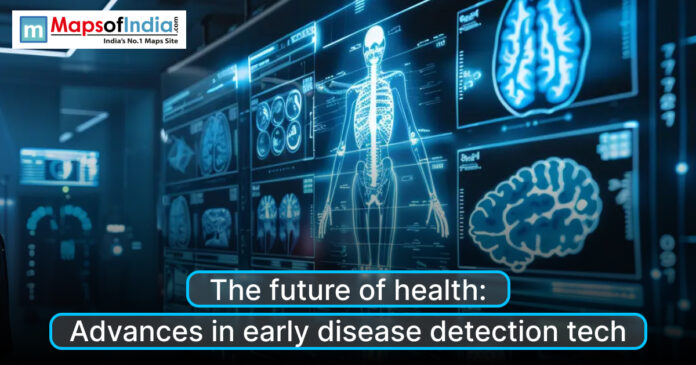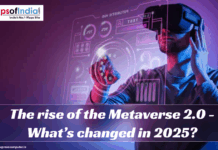Early disease detection technology is transforming the healthcare industry we know today. In recent years, healthcare technology has developed rapidly, developing tech like AI and wearables that spot illnesses before symptoms. This newly developed technology saves lives and cuts costs. According to the recent McKinsey report, this new tech reduces treatment expenses by 30%. AI analyses various kinds of available data to find patterns. Wearables healthcare devices monitor vitals in real time. These advancements have changed the healthcare industry. This makes disease detection accessible across the globe. Innovation thrives as AI spreads.
AI-Powered Imaging for Cancer Detection
AI has changed the healthcare industry for good. With many new innovations, like AI revolutionising cancer screening. The set of AI algorithms analyses X-rays and MRIs faster than humans. A recent study by Nature Medicine found that AI detects breast cancer with 94% accuracy than the traditional way. It reduces false positives by 11%. Google’s DeepMind tool can spot 50 eye diseases. AI processes thousands of images to obtain the result. This speeds diagnosis in underserved areas. Low-cost tools like portable scanners pair with AI apps to obtain accurate results. According to the WHO report, there are 20% better outcomes in low-income countries. Early detection of the disease can cut the chances of mortality by 25%. It empowers rural clinics with expert-level analysis.
Wearables and Biosensors for Continuous Monitoring
Wearable health devices track patients’ health 24/7. Devices like the Apple Watch detect irregular heartbeats. According to the Stanford Medicine study, it has been found that these devices identify atrial fibrillation with 84% accuracy. It alerts users to seek medical attention quickly. Biosensors present in patches monitor glucose non-invasively. According to the data from the Journal of Diabetes Science and Technology report these devices reduce hospital visits by 15%. Fitbit’s ECG app spots arrhythmias. These tools send data to apps for AI analysis. More than 500 million wearables are sold worldwide. They democratize monitoring. Low-cost options are available for developing nations. Early alerts prevent health complications. Innovation grows with sensor miniaturisation.
Genomics and AI for Personalised Detection
The Genomics technology sequences DNA for possible health risk assessment. AI analyses genes to look for possible disease markers. A Nature Genetics study says AI predicts breast cancer risk with 72% accuracy. These AIs use 313 genetic variants to obtain results. 23andMe’s tests screen for 10 conditions. Costs are also less for each test at $100. This price range is a 40% price reduction since 2020. AI can process massive datasets quickly to give results. This enables early interventions. In India, with the help of genomic screening it helps to cut rare disease diagnosis time by 50%. Personalised detection fosters equality. It tailors care to individuals.
Liquid Biopsies: Non-Invasive Cancer Screening
Liquid biopsies technology is used to detect cancer via blood. In this technology, they spot circulating tumour DNA to look for disease. According to the study conducted in Cancer Discovery, this technology identifies early-stage cancers with 89% sensitivity. This beats traditional methods and brings a change in disease identification technologies. Guardant Health’s test screens for 12 cancers. A New England Journal of Medicine report found 99% specificity. This test around the world costs $500 to 1000 per test. A McKinsey report predicts 30% adoption in high-risk groups. This process is painless and quick. AI analyses obtained samples for matching patterns available in its database from previously infected people. This gives access to screening in remote areas. Early detection of these diseases improves patients’ survival chances by 20%. Many international organisations, like the WHO, support the use of this technology. Liquid biopsies revolutionise oncology.
Microbiome Analysis for Preventive Health
The newly developed Microbiome analysis tech examines gut bacteria. Through this technology, diseases like diabetes are predicted. According to a Gut journal study, microbiome markers forecast obesity with 80% accuracy. Viome’s test analyses 10 million microbes to look for the disease. A Nature Biotechnology report says it suggests personalised diets. To conduct this test, the costs are $200 per kit. According to the PwC health report, this technology has seen 25% consumer adoption. AI processes stool samples to obtain insights. This can also help in early dietary changes. In Asian countries, microbiome tests reduced IBS symptoms by 15%. It makes preventive care accessible to everyone. Gut health is linked to the overall wellness of the human body.
Telemedicine and AI for Remote Detection
Telemedicine pairs with AI for distant diagnoses. Apps like Teladoc use AI chatbots to identify the symptoms. According to the JAMA Network study, these apps detect the flu with 92% accuracy. Use of these applications also reduces visits to the clinics by 30%. In rural India, AI telemedicine screens are also used for TB. A recent WHO report notes 2 million cases detected. For these telemedicine costs are $5 per consult. A recent McKinsey digital health report predicted 50% growth in this technology. AI can also analyse your voice and look for the signs of depression. This also helps in mental health screening. Telemedicine bridges gaps in healthcare access. It tries to provide equality in healthcare access.
Ethical Considerations in Detection Tech
The early detection of any disease is good, but on the other hand, this tech is raising questions related to ethics. Privacy concerns are rapidly growing as patients’ data is collected on an online database. According to the recent OECD report, more than 60% of users worry about data breaches. AI bias in diagnostics affects minorities. According to the study conducted in Nature Medicine 15% error rates were found for darker skin in cancer AI detection. Access inequality exists in low-income areas. Regulations like the EU’s AI Act are required to keep transparency in this system. A Deloitte ethics guide calls for inclusive datasets. Balancing innovation and equity is key to the future.
Conclusion
Early disease detection tech is the future of the healthcare industry. AI imaging spots cancer accurately in the human body. Wearables are used to monitor vitals constantly in real time and notify if the possibility of a problem occurs. Genomics predicts risks precisely. Liquid biopsies screen non-invasively. Microbiome analysis prevents illnesses. Telemedicine has reached remote corners of the world. Ethics ensure fair use. A McKinsey report says it cuts costs by 30%. AI democratisation can lead the way to achieving global equality. It can also help to empower underdeveloped communities. Innovation flourishes with accessible tools. The future is healthier and more equitable.




